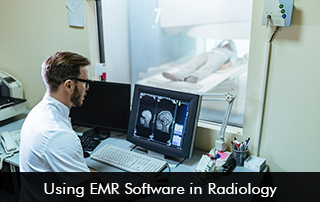Radiology is important in today’s medical world. As imaging gets more complicated and relies more on data, Radiology EMR Software is crucial for managing how things work in a clinic, making sure diagnoses are accurate, and ultimately helping patients. This software is made specifically for radiologists, so it’s more specialized than regular EMR Systems and deals with the specific needs of imaging departments.
What is Radiology EHR Software?
Radiology Electronic Medical Records Software is a specialized computer system for medical records, tailored specifically for doctors and technicians working with medical images. It helps them with every step of their process, from when a provider orders an imaging test to when the radiologist interprets the images and writes up a report. These specialized software solutions are tightly connected to the systems that store and manage medical images (like PACS and RIS), making it easy to view and organize all pictures.
Key Features in Radiology EMR Software
Radiology/Imaging EHR Software comes packed with a bunch of sophisticated tools and features, including:
Image Viewing and Storage: As it’s linked with PACS, radiologists can pull up high-definition images right inside the Electronic Medical Records (EMR) Software, making it convenient.
Radiology Report Templates: The pre-set templates make reports consistent and cut down on mistakes.
Voice Recognition and Dictation: Reporting gets much faster with real-time transcription that turns speech into text present in the Radiology EHR Software.
Order Management: Ordering and scheduling CT scans, MRIs, X-rays, and ultrasounds is made easier and quicker with the software.
Decision Support: Smart AI tools help with analyzing images, pointing out anything unusual, and even suggesting possible diagnoses.
Seamless Sharing: Imaging results can be securely shared with other doctors through HIEs or patient portals. This ensures that care teams are on the same page to deliver high-quality patient care.
Benefits for Radiologists
Radiologists see big gains in how smoothly their work goes and how accurately they diagnose, all with Radiology EMR Software. AI tools and voice recognition tools enable them to spend less time on paperwork and make fewer mistakes from manual data entry. As it works seamlessly with PACS, radiologists don’t have to constantly switch between different programs, giving them more time to study images and think about their patients. The software also gives instant alerts and uses organized templates, helping radiologists stay consistent and follow rules set by groups like RSNA and ACR when they write reports.
Moving Ahead
With advancements in imaging technologies and the increasing number of patients, having specialized Radiology EHR Software becomes essential. It helps radiology practices become more organized, speeds up report generation, and ultimately leads to better patient care. When radiologists have access to appropriate tools, they can provide more precise diagnoses and enhance communication among all healthcare providers involved.








